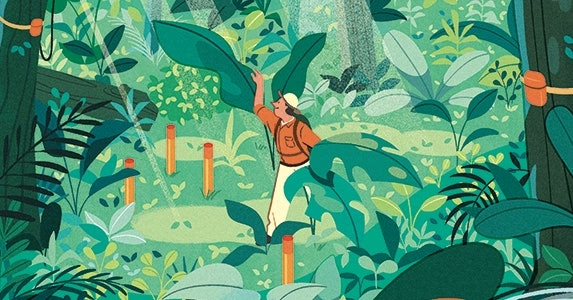you are here A lush forest. Sunlight streams through the bright green canopy, casting dappled shadows on the ground. Trees tower above delicate ferns, wildflowers and colorful mushrooms. A deer slinks behind a bush. But there are subtle signs of human intervention. Small electronic devices collect critical data about potential threats, such as drought or pests, and transmit it miles away.
Technology has long been used to study animals and plants in forests, but it is rapidly evolving and becoming smaller, smarter and more interconnected. Some devices are so small that they can be placed on a single leaf. “Forests present completely new challenges for developers of such devices,” says Ulrike Wallraabe, professor of microsystems technology. Here, technology has to withstand ever-changing conditions, from fluctuations in temperature to rain and snowfall and even strange creatures like rats.
A new generation of smart devices will provide unprecedented insight into our forests. “Drones are already monitoring large areas of the forest, but they can’t explain why some trees are thriving and others are struggling,” Wallraab said. “We need to understand what is happening on a small scale and over the long term.”
Wohlrabe and his colleagues are working on a variety of devices that can be deployed from the ground to the trees, transmitting data from Germany’s Black Forest to their lab at the University of Freiburg. At the same time, scientists and engineers at other companies are also focused on making their devices unobtrusive and ultimately self-sustaining.
Silvanet Wildfire Sensor
Time is of the essence when fighting forest fires. A trunk-mounted sensor can “smell” telltale gases such as hydrogen or carbon monoxide and alert firefighters within the first hour, before satellites or cameras spot an open flame. German startup Dryad Networks has incorporated AI into solar-powered sensors to reliably distinguish between an actual fire and, say, a passing diesel truck.
tree beer
Digital dendrometers free forest managers from tedious tasks. As the tree grows, the rubber band wrapped around the trunk stretches and sends data directly to the computer. Brazilian startup Treevia’s lightweight device can also be attached to seedlings. It is also equipped with humidity and heat sensors to provide insight into the impact of climate on reforested areas.
guardian
What does it take to catch illegal loggers and poachers? A smartphone is a good start. Rainforest Connection’s recycled solar-powered smartphone listens for chainsaws and gunshots within a one-mile radius. Records are sent to the cloud for analysis and alerts local authorities in near real-time. The device also provides insight into the animal’s distribution and vocal behavior.
BiodivX Drone
As animals move through trees, they shed DNA through their feces, skin, and hair. This innovative drone collects what is known as environmental DNA (eDNA) from leaves and branches with particles attached to adhesive strips. Swiss scientists have programmed a drone to navigate autonomously through dense forests and hover steadily around branches to collect samples.
leaf sensor
Wohlraabe and his team at the University of Freiburg have developed a glass capsule that measures gas exchange between a leaf and its surroundings. It can detect certain chemicals that trees release under stress such as drought, infestation, and disease. The capsules are transparent, allowing sunlight to reach them without impairing leaf function.
Plant-e
When sunlight is limited, most devices are powered by batteries. Plant-e, a Dutch company spun out of Wageningen University, uses natural processes. Plants produce organic substances through photosynthesis. Some is used for growth, but the rest goes to the soil. The bacteria break down this material, releasing electrons that Plant-e uses to power its sensors.
seed dropping drone
To expand and accelerate tree-planting efforts, several companies, including UK-based Dendra Systems, have developed cutting-edge drones. Loaded with a series of seeds, these drones hover over the target area and release their valuable cargo. This is especially useful in remote areas that are difficult for people to access. By recording the exact location of the fall site, foresters can monitor the growth and health of newly planted trees.
This article appears in the January/February 2025 issue of the magazine. wired British magazine.
(Tag Translation) Science

